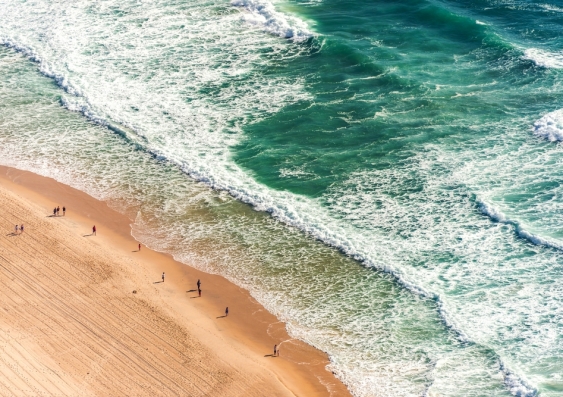Recent SPF testing has raised concerns over sunscreen labelling, prompting questions about consumer trust, regulation, and how Australians make health-critical decisions.
Most of us rely on the label information when choosing a sunscreen, trusting that a SPF 50+ label means a strong, reliable protection. According to by consumer group ╠¤16 popular sunscreens have failed to meet the SPF claims advertised on their packaging.╠¤
The results have raised questions about how sunscreen products are regulated, how consumers make purchasing decisions, and what happens when the trust placed in a product designed to protect health is undermined.
тАЬMost of us are told to apply sunscreen that is at least SPF 30 or above,тАЭ says Professor Nitika Garg from the School of Marketing at ║┌┴╧═Ї┤ґ╩┬╝╟ Business School. тАЬSo the SPF 50+ label gives consumers comfort. ItтАЩs a quick, accessible signal that theyтАЩre doing the right thing and they rightly trust that if a brand is saying itтАЩs SPF 50+, somebody has taken a look at it and approved it.тАЭ
In Australia, most sunscreens are regulated by the (TGA) and for therapeutic goods before being approved for sale, including meeting testing and labelling requirements тАУ in the TGAтАЩs words, it is a that тАЬstatements on sunscreen labels are truthful and not misleading.тАЭ But even with these systems in place, consumers often assume that the label perfectly reflects real-world performance, and that assumption is now being questioned.
Have Australian consumers now lost trust in these popular sunscreen brands? And how much do Australians rely on branding and packaging to make health-critical decisions?
Why Australians trust sunscreen labels
Sunscreen is one of those products most Australians use without much second-guessing, says Prof. Garg. Consumers place trust in SPF numbers and product claims because they offer a shortcut to decision-making, and because the manufacture of sunscreens is strictly regulated in Australia.
тАЬPeople are time-poor. They donтАЩt want to spend time researching every product, especially for something like sunscreen thatтАЩs used regularly. They rely on the brand and the label to give them the information they need so they donтАЩt have to do it themselves,тАЭ says Prof. Garg.
While testing with the TGA before going on shelf is designed to protect consumers, recent testing by CHOICE has highlighted how discrepancies between labelled and actual SPF performance can occur, raising questions about how consumers interpret labels and how much they trust the process behind them.╠¤
That trust often extends beyond the product to the system behind it. тАЬConsumers may not always know the name of the agency involved, but they trust that in a country like Australia, products like sunscreen go through regulatory checks,тАЭ she says. тАЬAnd in this case, that trust is backed by TGA; there are processes in place to catch issues and ensure products meet safety standards.тАЭ The TGA is investigating the CHOICE findings, and тАЬтАЭ.╠¤
When faced with several sunscreens offering similar claims, consumers typically rely on three main criteria when choosing their sunscreen: SPF rating, added features (like water resistance), and price. тАЬEach person has their own set of priorities,тАЭ says Prof. Garg. тАЬIf youтАЩre at the beach with kids, you might care more about whether itтАЩs water-resistant. If youтАЩre going out for a short walk, SPF might be enough.╠¤ Price is another big deciding factor.тАЭ
Prof. Garg says that this layered decision-making process is why the SPF label holds such power and why any mismatch between promise and performance can have negative consequences for trust and behaviour.
ItтАЩs taken years to build sunscreen use into a daily habit. We donтАЩt want to see that reversed overnight. Government agencies should reinforce that sunscreen is still essential, and help consumers understand which products are reliable.
What is SPF and why does it matter?
SPF, or sun protection factor, measures how effectively a sunscreen shields you from ultraviolet B (UVB) radiation, the kind responsible for sunburn and a driver of skin cancer, says Conjoint Associate Professor Deshan Sebaratnam, from the School of Clinical Medicine at ║┌┴╧═Ї┤ґ╩┬╝╟.
тАЬIf you would normally burn with two minutes of sun exposure, wearing SPF 30 sunscreen means it would take around 60 minutes to burn,тАЭ says A/Prof. Sebaratnam. тАЬWearing SPFтАп50 would mean about 100 minutes before burning.тАЭ
тАЬSPFтАп50 lets about 2тАп% of UVB through, while SPFтАп30 lets about 3.3тАп% through,тАЭ he says. ItтАЩs this extra protection that can make a real difference, especially in Australia, where are among the highest globally.
With will develop skin cancer by retirement age and of melanoma every six hours, the risks of poor sun protection are clear.╠¤
тАЬSkin cancer is our most common cancer, the most expensive to the healthcare system, but also the most preventable,тАЭ he says. тАЬAustralians need to feel confident that the measures they are taking, like wearing sunscreen, are effective.тАЭ
Media enquiries
For any related media enquiries, please contact Katie Miller, News and Content Coordinator.╠¤
░╒▒Ё▒Є:╠¤0408 033 715
╖б│╛▓╣╛▒▒Є:╠¤katie.miller1@unsw.edu.au
Losing faith in the brand тАУ did CHOICE do more harm than good?
The CHOICE test results may have sparked concern about misleading marketing, but Prof. Garg warns that the way these findings were communicated could have done more harm than good.
тАЬThe implicit trust consumers had in those labels because they thought they were being backed by some scientific evidenceтАж falls apart,тАЭ says Prof. Garg. тАЬAs a consumer, you think: where do I go now? What do I buy? You feel betrayed.тАЭ
Consumers are especially likely to trust independent third parties like CHOICE, she explains, because they are seen to have тАЬno skin in the game.тАЭ Unlike companies with something to sell, independent testers appear unbiased. тАЬThatтАЩs the reason why CHOICE data or CHOICE conclusions make more of an impact on consumers.тАЭ
But when media headlines arenтАЩt framed carefully, that trust can quickly turn to confusion. Prof. Garg says the coverage of the CHOICE findings may have done more harm than good. тАЬThere is no sunscreen they tested that didnтАЩt provide protection at all,тАЭ she says. тАЬBut some consumers may only read the headline and walk away thinking none of them work, which is extremely harmful. Not using anything is not an option.
тАЬEvery agency, every person in the chain of delivering this news has some responsibility to present information in a way that is easy, but also avoids misleading interpretations,тАЭ says Prof. Garg. тАЬMisleading headlines risk losing consumer trust, and when it comes to a product as important as sunscreen, even one person lost is one too many.тАЭ
She also adds that rebuilding trust will be difficult unless brands and government agencies step in. тАЬIf a brand has contradictory evidence, they need to share it, and they need to back up their claims with science. Simply saying тАШwe stand behind our productтАЩ isnтАЩt going to help. Brands must give people clear, scientific evidence to earn back trust.тАЭ
Prof. Garg says that public reassurance is just as important. тАЬItтАЩs taken years to build sunscreen use into a daily habit. We donтАЩt want to see that reversed overnight. Government agencies should reinforce that sunscreen is still essential, and help consumers understand which products are reliable.тАЭ
How do I choose sunscreen now?╠¤
In light of the CHOICE findings, many Australians are asking: how do I know which sunscreen to trust?
A/Prof. Sebaratnam says the best approach is to stick with broad-spectrum SPF 50+ products and focus on how you use them. тАЬOne brand isnтАЩt better than another, the best sunscreen is the one that you are motivated to wear,тАЭ he says.
Correct application is just as important as choosing the right product. тАЬApply it 20 minutes before you head out, and make sure you use the right amount, about a teaspoon for your face and about a shot glass for your entire body,тАЭ says A/Prof. Sebaratnam. тАЬReapply every four hours, or more frequently if youтАЩre sweating or swimming.тАЭ╠¤
And sunscreen is only one part of the picture. тАЬAustralians should follow the slip, slop, slap, seek, slide rule, wearing a broad-brimmed hat, sunglasses and long-sleeved clothing, seeking shade and avoiding the sun in the middle of the day,тАЭ he says.
Prof. Garg recommends sticking with the brands that performed well in the CHOICE testing until further evidence is available. тАЬIf you have a product that tested in the 40s or higher, like Cancer Council or Nivea, keep using it,тАЭ she says. тАЬItтАЩs better to choose something thatтАЩs been shown to work than to throw your hands up and stop using sunscreen altogether.тАЭ
For anyone concerned about their skin, A/Prof. Sebaratnam also recommends seeking professional advice. тАЬIf Aussies have any concerns about their skin, they should see a doctor, either their GP or a specialist dermatologist.тАЭ
╠¤
Related stories
-

Vitamin B3, niacinamide and reducing skin cancer risk: what does the research say?
-

Slip, slop, slurp! The surprising science of sunscreen, sand and ice cream
-

While drowning numbers soar, beach safety programs are largely unevaluated
-

Cabana drama: 5 expert tips on how not to be branded a twit when using a beach tent






